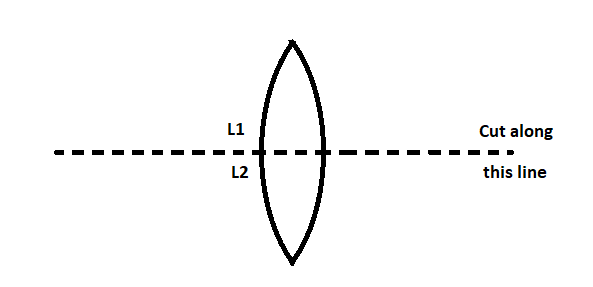
A convex lens of focal length $f$ is cut into halves as shown. Light rays parallel to the principal axis are incident on one half of the lens (say ${L_1}$). This will form an image at:

(A) $f$
(B) $\dfrac{f}{2}$
(C) $2f$
(D) $\dfrac{f}{4}$
Answer
219.6k+ views
Hint: A convex lens is said to be cut into two halves as shown in the diagram along the principal axis of the lens. The incident light rays are assumed to be parallel to the principal axis. It will be falling on one half of the lens. We assume it to be the upper part ${L_1}$ of the lens. Now we have to find the point where the image is formed.
Complete step by step solution:
We know that the lens is cut horizontally along the principal axis. Therefore there will not be any change in the radius of curvature of the lens. It will remain the same.
According to lens makers formula, the focal length of the lens is given by
$\dfrac{1}{f} = (n - 1)\left[ {\dfrac{1}{{{R_1}}} - \dfrac{1}{{{R_2}}}} \right]$
Where $f$stands for the focal length of the lens, $n$stands for the refractive index of the lens and ${R_1}$and ${R_2}$stands for the radii of curvature of the lens.
Since there will not be any change in the radii of curvature of the lens ${R_1}$and${R_2}$will remain the same before and after cutting the lens into two halves. Therefore there will not be any change in the focal length of the lens. The focal length will remain the same before and after cutting the lens.
The answer is:
Option (A): $f$
Note:
A lens that converges a light beam passing through it is called a converging lens. A convex lens is a converging lens. If a lens diverges the light beam it is called a diverging lens. A concave lens is a diverging lens. The distance between the optic center and the principal focus of the lens is called the focal length of the lens.
Complete step by step solution:
We know that the lens is cut horizontally along the principal axis. Therefore there will not be any change in the radius of curvature of the lens. It will remain the same.
According to lens makers formula, the focal length of the lens is given by
$\dfrac{1}{f} = (n - 1)\left[ {\dfrac{1}{{{R_1}}} - \dfrac{1}{{{R_2}}}} \right]$
Where $f$stands for the focal length of the lens, $n$stands for the refractive index of the lens and ${R_1}$and ${R_2}$stands for the radii of curvature of the lens.
Since there will not be any change in the radii of curvature of the lens ${R_1}$and${R_2}$will remain the same before and after cutting the lens into two halves. Therefore there will not be any change in the focal length of the lens. The focal length will remain the same before and after cutting the lens.
The answer is:
Option (A): $f$
Note:
A lens that converges a light beam passing through it is called a converging lens. A convex lens is a converging lens. If a lens diverges the light beam it is called a diverging lens. A concave lens is a diverging lens. The distance between the optic center and the principal focus of the lens is called the focal length of the lens.
Recently Updated Pages
[Awaiting the three content sources: Ask AI Response, Competitor 1 Content, and Competitor 2 Content. Please provide those to continue with the analysis and optimization.]

JEE Main 2023 (January 24th Shift 1) Physics Question Paper with Answer Key

JEE Main 2023 (January 24th Shift 1) Chemistry Question Paper with Answer Key

Aqueous Tension and Its Formula Important Concepts for JEE

JEE Main 2023 (April 11th Shift 1) Physics Question Paper with Answer Key

Colour of Ions and Precipitates Important For JEE

Trending doubts
Understanding Uniform Acceleration in Physics

Understanding Collisions: Types and Examples for Students

Understanding Atomic Structure for Beginners

Understanding Centrifugal Force in Physics

JEE Main Marking Scheme 2026- Paper-Wise Marks Distribution and Negative Marking Details

Degree of Dissociation: Meaning, Formula, Calculation & Uses

Other Pages
Understanding Electromagnetic Waves and Their Importance

Understanding Average and RMS Value in Electrical Circuits

Understanding Entropy Changes in Different Processes

Common Ion Effect: Concept, Applications, and Problem-Solving

Diffraction of Light - Young’s Single Slit Experiment

JEE Main 2025-26 Mock Test: Ultimate Practice Guide for Aspirants




